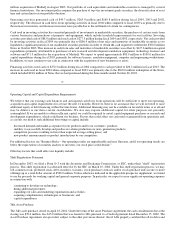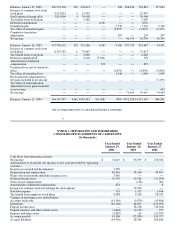NVIDIA 2004 Annual Report Download - page 28
Download and view the complete annual report
Please find page 28 of the 2004 NVIDIA annual report below. You can navigate through the pages in the report by either clicking on the pages listed below, or by using the keyword search tool below to find specific information within the annual report.
Revenue from the sale of Xbox processors to Microsoft during fiscal 2002, fiscal 2003 and fiscal 2004 accounted for 9%, 23% and
15%, respectively, of our total revenue.
29
We may not be able to realize the potential financial or strategic benefits of business acquisitions and that could hurt our
ability to grow our business and sell our products.
In the past we have acquired and invested in other businesses that offered products, services and technologies that we believed would
help expand or enhance our products and services or help expand our distribution channels. For any previous or future acquisition or
investment, the following risks could impair our ability to grow our business and develop new products and, ultimately, could impair
our ability to sell our products:
· difficulty in combining the technology, operations or workforce of the acquired business;
· disruption of our ongoing businesses;
· difficulty in realizing the potential financial or strategic benefits of the transaction;
· difficulty in maintaining uniform standards, controls, procedures and policies; and
· possible impairment of relationships with employees and customers as a result of any integration of new businesses and
management personnel.
In addition, the consideration for any future acquisition could be paid in cash, shares of our common stock, or a combination of cash
and common stock. If the consideration is paid with our common stock, existing stockholders would be further diluted.
Provisions in our certificate of incorporation, our bylaws and our agreement with Microsoft could delay or prevent a change
in control.
Our certificate of incorporation and bylaws contain provisions that could make it more difficult for a third party to acquire a majority
of our outstanding voting stock. These provisions include the following:
· the ability of the board of directors to create and issue preferred stock without prior stockholder approval;
· the prohibition of stockholder action by written consent;
· a classified board of directors; and
· advance notice requirements for director nominations and stockholder proposals.
On March 5, 2000, we entered into an agreement with Microsoft in which we agreed to develop and sell graphics chips and to license
certain technology to Microsoft and its licensees for use in the Xbox. In the event that an individual or corporation makes an offer to
purchase shares equal to or greater than 30% of the outstanding shares of our common stock, Microsoft has first and last rights of
refusal to purchase the stock. The provision could also delay or prevent a change in control of NVIDIA.
Risks Related to Our Competition
The 3D graphics, platform processor and handheld industries are highly competitive and we may be unable to compete.
The market for GPUs, MCPs and UMPs for PCs and handhelds in which we compete is intensely competitive and is characterized by
rapid technological change, evolving industry standards and declining average selling prices. We believe that the principal competitive
factors in this market are performance, breadth of product offerings, access to customers and distribution channels, backward−forward
software support, conformity to industry standard APIs, manufacturing capabilities, price of digital media processors and total system
costs of add−in boards and motherboards. We expect competition to increase both from existing competitors and new market entrants
with products that may be less costly than ours, or may provide better performance or additional features not provided by our
products, which could harm our business.
30
Our primary source of competition is from companies that provide or intend to provide GPU and MCP solutions for the PC and
handheld segments. Our competitors include the following:
























